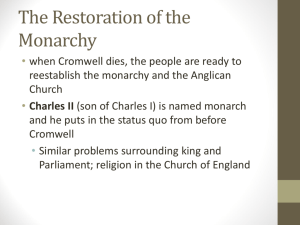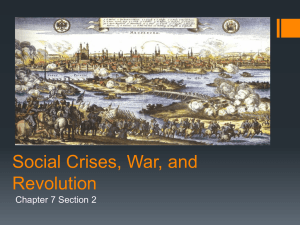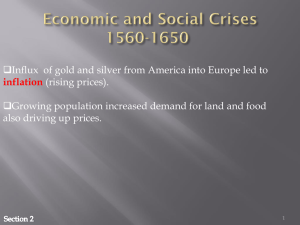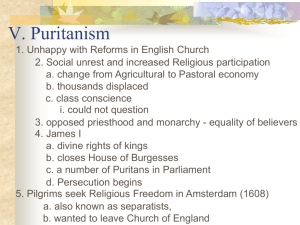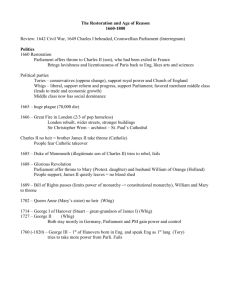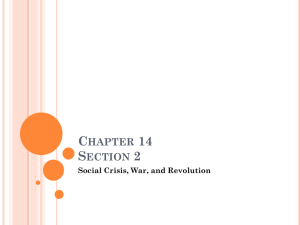CHAPTER 7.3 and 7.4 PPT.
advertisement
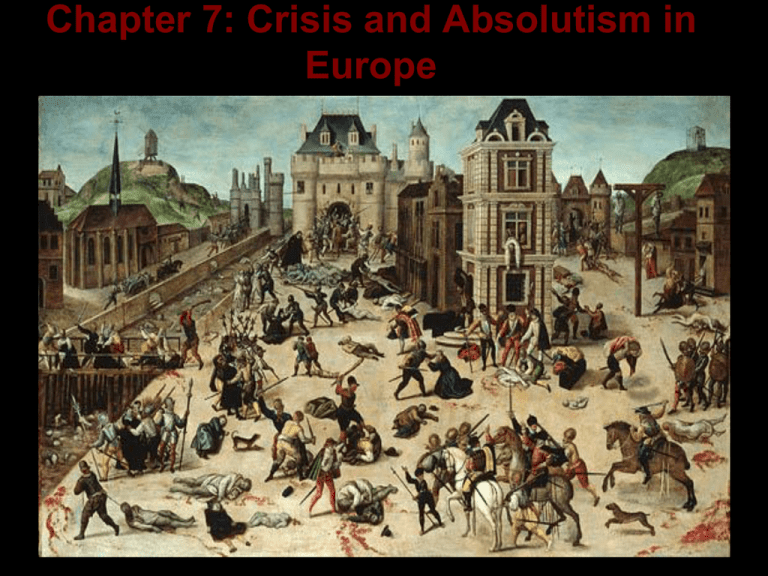
Chapter 7: Crisis and Absolutism in Europe 7.1 Europe in Crisis: The Wars of Religion French Wars of Religion By 1560, Calvinism and Catholicism had become militant – aggressive in trying to win converts and in eliminating each others authority French Wars of Religion (Civil War) – Between the Huguenots and the Catholics Huguenots (Bourbons) minority but made up 40-50% of nobility Catholics make up majority; party- ultraCatholics: recruit and pay for large armies • War goes on 30 years, 1589 Henry of Navarre (Bourbon) succeeded to he throne; realizes a Protestant would never be accepted as king; converts to Catholicism; fighting comes to an end • Edict of Nantes: recognized Catholicism as the official religion of France but allowed Huguenots the right to worship and the right to enjoy all political privileges Philip II and Militant Catholicism – Philip II inherited Spain, the Netherlands, and possessions in Italy and the Americas from his father Charles V – Phillip insisted absolute rule and strict conformity to Catholicism – Phillip tried to crush Calvinism in the Spanish Netherlands; 1566, Calvinist destroyed statues in Catholic churches; Phillip sent 10,000 troops to put down the rebellion; resistance continued until 1609 under the leadership of William the Silent; after the truce the northern provinces began to call themselves the United Provinces of the Netherlands – 1598, Phillip’s reign ended; treasury was bankrupt from fighting wars; government inefficient; armed forces out of date; result: power in Europe shifts to England and France. Philip II The England of Elizabeth – Elizabeth Tudor became the leader of protestant nations in Europe. – Elizabeth I repealed laws favoring Catholic; allowed religious tolerance, but the Church of England remained protestant. – Phillip II prepared to attack England and restore Catholicism; the armada that set sail in 1588 was too small and ill equipped to be able to defeat the English; after a few encounters with the English the Spanish retreated; many Spanish ships sank in a storm Spanish Armada Section 7.2: Social Crisis, War, and Revolution 4. Economic and Social Crisis: A. major problem was inflation; caused by: 1) gold and silver coming from the Americas and 2) population increase causes an increase in demand for all goods – both drive prices up 5. The Witchcraft Trials: A. The same religious zeal that led to the hunt of heretics also led to the hunt of witches. B. 16th and 17th Centuries, approximately 100,000 people were charged with witchcraft in Europe. The Accused People who were poor and without property were most often accused. 75% were women; single or widowed; over 50 yrs. Under intense torture, they confessed C. By 1650, witchcraft hysteria begun to lessen because people found it unreasonable to believe in the old view of a world haunted by evil spirits. The Witchcraft Trials Tombstones of the Victims “I have no hand in witchcraft.” “I am no witch!” “I am innocent!” “I know nothing of it!” “…I am wronged! “It is a shameful thing that you should mind these folks that are out of their wits.” “If it was the last moment I was to live, God knows I am innocent!” Village of Salem The house at 'Olde Burying Point' The House of Seven Gables Judge Corwin’s House “The house at the “Old Burying Point” Gallows Hill 6. The Thirty Years’ War: A. Takes place in the Holy Roman Empire; several small separate states; states paid little attention to their emperor; Ferdinand, inherited from brother Charles V B. War starts over religion; Northern states protestant; Southern states Catholic; led by the Hapsburgs C. Soon the war turned political: - France joins Sweden in fighting the Catholic Hapsburgs D. Peace of Westphalia ends the war. Terms: - all German states could choose their own religion - 300+ states of the Holy Roman Empire are recognized as independent; ends Holy Roman Empire - France gains territory from Germany and Spain; the Netherlands wins independence. 7. Revolution in England A. The Stuarts and Divine Right: - Elizabeth I dies; no heir; throne passes to her cousin James I of England (James VI of Scotland); He joins crowns – calls them Great Britain James believed in divine right; parliament assumed they ruled England with the king or queen; Tudor’s had James I of England The Puritans wanted to make The Church of England more protestant; problem begins in James I reign, but becomes a conflict in Charles I reign Charles believes in divine right; parliament passes a petition the king raising taxes without the consent of Parliament; put limits on the king’s power; he doesn’t accept petition Charles tries to impose more rituals on the Church of England; Puritans who could not accept these religious policies chose to go to America B. Civil War and the Commonwealth: - Civil War: fought between the Cavaliers\Royalist – supporters of the king and the Roundheads – they were led by Oliver Cromwell; parliament Cromwell was a military genius; put together the New Model Army; made up mostly of puritans; soldiers were well disciplined and trained in new military tactics; result: Roundheads win the war Cromwell purged parliament of members who did not support him; had Charles I executed; made England a commonwealth; eventually set up a military dictatorship Oliver Cromwell C. Restoration: Cromwell dies in 1658, parliament restores the throne to Charles II Charles II (sympathetic) and his brother James (outright) were catholic; therefore parliament debated the Exclusion Bill: barred professed Catholics from the throne; created two political groups: 1. the Whigs – wanted to excluded James and 2. the Tories – did not want to interfere with lawful succession to the throne; later they become political parties Charles dismisses parliament in 1861; dies in 1865; James II a devout Catholic becomes king; James appoints Catholic to all top positions Charles II D. A Glorious Revolution: A. A group of English noblemen invited William of Orange to invade England and take the throne because they are protestant; William’s wife, Mary is James II daughter; they raised an army and invaded England; took the throne with almost no bloodshed; James and his family fled to France – Becomes known as the Glorious Revolution Parliament offered William and Mary the throne only if they would accepted the English Bill of Rights; they do; destroys the divine-right theory of kingship Bill of Rights: - Parliament has the right to make laws and levy taxes (Amendment #16) - armies could only be raised by parliament (Legislative Branch) - citizens had the right to bear arms and the right to a jury trial (Amendment #2 and #6) - created a limited monarch; king rules with laws and parliament is elected. (Executive Branch) Toleration Act of 1689: granted puritans, not Catholics, the right of free worship

